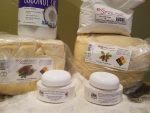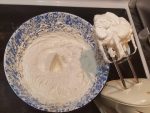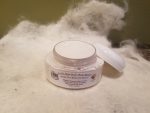Satin Skin Baby Bum Butter

This is a wonderful butter made of three of the most healing, moisturizing ingredients you can pamper your baby with. Whipped Organic Virgin Coconut Oil, Organic Shea Butter, and Organic Cocoa Butter & Zinc Oxide are the only ingredients in this soothing butter. There are no fragrances added to this as the natural odors of these ingredients are soothing enough. The Zinc Oxide helps inflammation and repels water so will help keep your baby’s bottom dry. The other ingredients will heal and sooth. Nothing artificial, all natural, because our babies deserve the best!
You can also add a Tablespoon of this to your bathwater or baby’s bathwater as it can form a protective layer on the skin that seals in moisture and acts as a barrier against harsh external toxins. There can be no claims that this will happen for you, of course, but the inherent qualities of the ingredients will speak for themselves.
There is more information below about all four of these ingredients and if you take the time to read these inserts you will definitely understand the value of using Jaxsoaps Satin Skin Baby Bum Butter!
What is Zinc Oxide?
Zinc oxide is a fine white powder that is insoluble in water. That simply means that if you dump a little zinc oxide into a cup of hot water and stir it around, you’ll just end up with powder and water. Zinc oxide can occur naturally as the mineral zincite but most zinc oxide is synthetically produced. (see wikipedia) You’ll find zinc oxide in a lot of products as an additive, and in the beauty world you will see it in diaper rash cream and in sunscreen.
This is a wonderful butter made of three of the most healing, moisturizing ingredients you can pamper your baby with. Whipped Organic Virgin Coconut Oil, Organic Shea Butter, and Organic Cocoa Butter & Zinc Oxide are the only ingredients in this soothing butter. There are no fragrances added to this as the natural odors of these ingredients are soothing enough. The Zinc Oxide helps inflammation and repels water so will help keep your baby’s bottom dry. The other ingredients will heal and sooth. Nothing artificial, all natural, because our babies deserve the best!
You can also add a Tablespoon of this to your bathwater or baby’s bathwater as it can form a protective layer on the skin that seals in moisture and acts as a barrier against harsh external toxins. There can be no claims that this will happen for you, of course, but the inherent qualities of the ingredients will speak for themselves.
There is more information below about all four of these ingredients and if you take the time to read these inserts you will definitely understand the value of using Jaxsoaps Satin Skin Baby Bum Butter!
What is Zinc Oxide?
Zinc oxide is a fine white powder that is insoluble in water. That simply means that if you dump a little zinc oxide into a cup of hot water and stir it around, you’ll just end up with powder and water. Zinc oxide can occur naturally as the mineral zincite but most zinc oxide is synthetically produced. (see wikipedia) You’ll find zinc oxide in a lot of products as an additive, and in the beauty world you will see it in diaper rash cream and in sunscreen.
Why Zinc Oxide Works Like Magic in Diaper Rash Creams:
When you mix zinc oxide with hot emollients, butters, and oils the end result is a thick white cream. While the cream is still hot, you can see the powdery zinc oxide as a separate substance but as it cools the cream becomes a normal consistency and the powder dissolves.
Rub the zinc oxide cream on your skin and water droplets will sit on top of the cream. Wash your zinc oxide hands in warm water and you’ll still have beading water. The zinc oxide repels the water and keeps it away from your skin. This is exactly what it does on your baby’s body as well. Wet diapers won’t cause diaper rash because your baby has a layer of zinc oxide cream on that repels the wetness. It’s the best substance to use in diaper rash creams because it works so well at repelling moisture.
What is Shea Butter?
Shea butter is a skin superfood that comes from the seeds of the fruit of the Shea (Karite) tree and that is naturally rich in vitamins A, E and F. It offers UV protection (it is SPF ~6) and provides the skin with essential fatty acids and the nutrients necessary for collagen production. Shea butter has been used in Africa and other countries for years to improve skin and hair.
Repair Skin & Boost Collagen with Raw Shea Butter.
Shea Butter For baby care:
Shea butter is non-toxic and gentle enough to be applied on baby skin. Care should be taken to use organically made, unscented, pure Shea butter.
Shea butter can be used for baby massage in place of olive oil. Its oleic acid content is comparable to that of olive oil, but it has higher stearic acid content that make Shea butter is closer in composition to the fat naturally found in the skin. The butter can be applied all over the body or to selective areas such as elbows, knees and cheeks that tend to dry out faster in babies and young children.
Adding a spoonful of Shea butter to the bath water is another way to use it on babies. It can form a protective layer on the skin that seals in moisture and acts as a barrier to dust and other environmental contaminants.
Other Shea Butter Benefits:
Moisturizing:
The concentration of natural vitamins and fatty acids in Shea butter makes it incredibly nourishing and moisturizing for skin. It is often used to remedy dry skin and to help protect the skin’s natural oils.
Reduces Inflammation:
A 2010 study found that due to its cinnamic acid and other natural properties, shea butter was anti-inflammatory. (source) One compound in particular, lupeol cinnamate, was found to reduce skin inflammation and even potentially help avoid skin mutations. This also makes it beneficial for some people with acne.
Skin Smoothing:
Shea butter aids in the skin’s natural collagen production and contains oleic, stearic, palmitic and linolenic acids that protect and nourish the skin to prevent drying. With long term use, many people report skin softening and strengthening as well as wrinkle reduction.
For baby care:
Shea butter is non-toxic and gentle enough to be applied on baby skin. Care should be taken to use organically made, unscented, pure Shea butter.
Shea butter can be used for baby massage in place of olive oil. Its oleic acid content is comparable to that of olive oil, but it has higher stearic acid content that make Shea butter is closer in composition to the fat naturally found in the skin. The butter can be applied all over the body or to selective areas such as elbows, knees and cheeks that tend to dry out faster in babies and young children.
Adding a spoonful of Shea butter to the bath water is another way to use it on babies. It can form a protective layer on the skin that seals in moisture and acts as a barrier to dust and other environmental contaminants. If the natural nutty smell of Shea butter is not to your liking, mixing in a drop of pure essential oil of your choice to the bath can solve the problem.
What Is Cocoa Butter?
Cocoa beans are native to parts of Central and South America and have been harvested to make natural skin moisturizers in places like Mesoamerica and the Caribbean for centuries. Because it has a mild fragrance, a smooth texture (due to its “emollient” properties) and is ultra-hydrating, cocoa butter is a very popular ingredient today around the world in all sorts of commercial beauty products.
Cocoa butter is a healthy fat, mostly saturated just like coconut oil. The amount of saturated fat it contains (as opposed to unsaturated fat) is between 57 percent to 64 percent of the total fat content, depending on the exact kind. Among the different types of fatty acids are:
stearic acid (about 24 percent to 37 percent of total fat content)
palmitic acid (24 percent to 30 percent)
myristic acid (0 percent to 4 percent)
arachidic acid (around 1 percent)
lauric acid (only about 0 percent to 1 percent)
How about raw cocoa butter — what makes this different, and is it any better than cocoa butter that’s been heated? Raw cocoa butter, sometimes labeled as “pure cocoa butter,” isn’t heated to very high temperatures during manufacturing processes, which means it usually retains more of the healthy fats and other compounds found naturally in cocoa beans.
1. Prevents Skin Dryness and Peeling
Cocoa butter makes an excellent skin moisturizer, plus it does more than just hydrate the skin — it helps actually heal it from the inside out too. It’s a great source of natural antioxidants that are found in cocoa beans (the same kinds found in real, dark chocolate that are tied to benefits like heart health and improved cognitive functioning). Saturated fats are especially beneficial for healing dry, cracked skin because they’re easily absorbed and remain on the skin for hours.
Natural hydrating products also tend to cause much less irritation for people with sensitive skin while still locking in moisture, since they’re free from additives, fragrances, colors and dyes used in most commercial products.
If you prefer the more liquidy texture of coconut oil and its tropical smell, you can also blend pure cocoa butter and coconut oil together. If you have extra sensitive, dry skin (such as eczema), always use pure cocoa butter and perform a patch test first to make sure you don’t have a sensitivity and wind up developing any negative reactions.
2. Heals Chapped Lips
One of the most popular ways to use cocoa butter is on the lips and you can apply Satin Skin to your lips as well.
Cocoa butter is an emollient, which means it adds a protective layer of hydration to your lips, useful for blocking the effects of very cold temperatures, sun damage or indoor heat, which can leave your lips dry. (2)
3. Fights Signs of Aging
Cocoa butter contains compounds called cocoa mass polyphenols, which some studies have found can help diminish signs of aging, plus soothe sensitive skin suffering from dermatitis or rashes. Polyphenols are types of antioxidants that promote health both internally when eaten and when used topically on the skin. Cocoa’s polyphenols have been found to fight various chronic diseases, degeneration of the skin, sensitivities and even cell mutations. (3)
Research shows that its polyphenols have several positive indicators for skin health, including improved skin elasticity and skin tone, better collagen retention/production, and better hydration. When comparing cocoa butter to commercially available products, both showed positive results, but only cocoa butter is free from potentially harmful or irritating ingredients.
4. Soothes Burns, Rashes and Infections
Rub a small amount of pure cocoa butter into burnt skin to help skin replenish. Just make sure it’s pure and doesn’t contain any alcohol, fragrances/perfumes or other additives that can lead skin to become even more inflamed and sensitive.
It’s is even gentle enough to be used as a natural treatment for eczema or dermatitis. It’s also a rash natural remedy.
Virgin Coconut Oil:
Coconut oil is famous throughout the world not only as an edible oil and hair tonic, but also as an excellent massage oil and smoothener for the skin. In the tropical parts of the world where coconuts are readily available and used in many ways, natives commonly spread coconut oil on their skin, as they believe that it protects from the sun’s harmful rays. So this natural oil, without any chemical or additives, can protect the skin in some of the hottest and sunniest places on earth better than our processed and artificial sun creams?
The question is, what makes coconut oil so beneficial for the skin? Before we can understand how coconut oil achieves all of its impressive benefits that people around the world claim, let’s look into the constituents of coconut oil and their respective properties that might make them useful for maintaining skin health.
Coconut Oil- Composition
Saturated Fats: Predominantly, these saturated fats are medium chain fatty acids or triglycerides. When applied on the skin, they keep it smooth to the touch. Due to the presence of these fats, coconut oil also retains the moisture content of the skin, as the fats eliminate moisture loss through the pores on skin. When ingested through the regular consumption of coconut oil, these fats deposit under the skin, thus keeping it healthy and smooth, giving it an even tone and reducing the appearance of the pores.
Capric /Caprylic/Lauric acid: These are not very different from the medium chain fatty acids, but it is still important to mention them separately here, since they have their own contributions. These three fatty acids have strong disinfectant and antimicrobial properties. As a result, when applied on the skin, coconut oil protects from microbial infections that can get into open wounds or even enter the body through the pores. This microbial action can be experienced even if coconut oil is taken internally, as the fatty acids boost the immunity when converted to monocaprins and monolaurins.
Furthermore, capric, caprylic, and lauric acids are easily broken down chains of fatty acids, meaning that they contribute to usable energy in a quick and efficient way. This can be a major boost to your energy levels before a workout, which is why these powerful acids have also been linked to weight loss and management. Losing weight is a good way to improve the quality of your skin by reducing excess fat, stretch marks, and folds in the skin which can be unattractive. Having a healthy, toned body means that the skin maintains its tight grip around the muscles and bones.
Vitamin-E: The contributions of vitamin-E towards skin care are well known. It is essential for healthy skin growth, repair of wear & tear on the skin, keeping skin smooth and protecting against cracking. Above all, it prevents premature aging and wrinkling of the skin, since it has good antioxidant properties. 100 grams of coconut oil has about 0.1 mg of vitamin E, thus enhancing it skin-nourishing properties.
Anti-Aging Cream: Traditionally, coconut oil has been praised and popularized for its anti-aging properties.
Proteins: Like coconuts themselves, coconut oil is rich in many proteins. These proteins keep skin healthy and rejuvenated, both internally and externally. Proteins also contribute to cellular health and tissue repair, along with a wide range of other essential activities within the body. For any damaged cells on or near the skin, a healthy of flow of proteins guarantees their replacement at a normal rate, whereas people with protein-deficient diets heal slower and often develop more obvious scars due to the extended healing time.
The best property of coconut oil that makes it so beneficial for skin is that it does not become rancid. When you apply it on the skin, it can work for a longer time, unlike many other oils, without it getting rancid. Due to these various beneficial properties of coconut oil, it is used as an important ingredient in several skin care creams.




